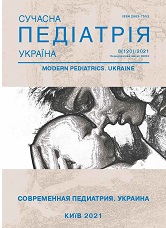Transplantation of vascularized epiphyseal graft of the proximal tibia in a child diagnosed with Ewing's sarcoma
DOI:
https://doi.org/10.15574/SP.2021.120.70Keywords:
vascularized epiphyseal graft transplantation, children, clinical caseAbstract
Bone reconstruction after complete surgical resection of a tumor in children with a growing skeleton is a surgical problem. A special problem of periarticular reconstruction of the proximal femur and acetabulum is a special structure and function that provides movement and resistance, so transplantation of only vascularized autograft of the tibia is not enough. The use of free bone revascularized autografts makes it possible to replace significant defects of tubular bones.
Clinical case. The case of transplantation of vascularized epiphyseal graft of the proximal tibia in a child diagnosed with Ewing's sarcoma of the proximal femur, after tumor resection in the Department of Reconstructive and Plastic Microsurgery National Children's Specialized Hospital MOZ of Ukraine «OHMATDYT».
Conclusions. Transplantation of a vascularized epiphyseal graft of the proximal tibia with preserved articular surface after removal of the tumor together with the affected fragment of the femur, restores joint mobility and, most importantly, growth potential, which is undeniable in children. The treatment tactics proved to be effective and saved the child's life.
The research was carried out in accordance with the principles of the Helsinki declaration. The informed consent of the patient was obtained for conducting the studies.
No conflict of interest was declared by the authors.
References
Capanna RB, Campanacci M. (1993). A new technique for reconstructions of large metadiaphiseal bone defects. Orthop Traumatol. 3: 159-177. https://doi.org/10.1007/BF02620523
Emmanuel PE, Ellen YL, Edward HM. (2012). Vascularized proximal fibular epiphyseal transfer for shoulder reconstruction after tumor resection: a case report. Acta Medica Philippina. 46 (2): 64-73. https://doi.org/10.47895/amp.v46i2.2176
Innocenti M, Delcroix L, Romano GF. (2005). Epiphyseal transplant: harvesting technique of the proximal fibula based on the anterior tibial artery. Microsurgery. 25 (4): 284-292. https://doi.org/10.1002/micr.20130; PMid:15934045
Reed DR, Hayashi M, Wagner L, Binitie O, Steppan DA, Brohl AS, Shinohara ET, Bridge JA, Loeb DM, Borinstein SC, Isakoff MS. (2017). Treatment pathway of bone sarcoma in children, adolescents and young adults. Cancer. 123 (12): 2206-2218. https://doi.org/10.1002/cncr.30589; PMid:28323337 PMCid:PMC5485018
Taylor GI, Miller GD, Ham FJ. (1975). The free vascularized bone graft. A clinical extension of microvascular techniques. Plast Reconstr Surg. 55 (5): 533-544. https://doi.org/10.1097/00006534-197505000-00002; PMid:1096183
Downloads
Published
Issue
Section
License
Copyright (c) 2022 Modern pediatrics. Ukraine

This work is licensed under a Creative Commons Attribution-NonCommercial 4.0 International License.
The policy of the Journal “MODERN PEDIATRICS. UKRAINE” is compatible with the vast majority of funders' of open access and self-archiving policies. The journal provides immediate open access route being convinced that everyone – not only scientists - can benefit from research results, and publishes articles exclusively under open access distribution, with a Creative Commons Attribution-Noncommercial 4.0 international license (СС BY-NC).
Authors transfer the copyright to the Journal “MODERN PEDIATRICS. UKRAINE” when the manuscript is accepted for publication. Authors declare that this manuscript has not been published nor is under simultaneous consideration for publication elsewhere. After publication, the articles become freely available on-line to the public.
Readers have the right to use, distribute, and reproduce articles in any medium, provided the articles and the journal are properly cited.
The use of published materials for commercial purposes is strongly prohibited.

